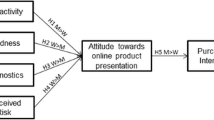Abstract
Since the early days of the Internet, gender gap has existed in using the Internet, and it is particularly evident for online shopping. Females perceive higher level of risk for online shopping, and as a result, they tend to hesitate to make purchase online. Online consumer reviews can effectively mitigate such perceived risk by females and thereby attract them to buy online. This study investigates the effect of online consumer reviews on consumer’s purchase intention. In particular, we examine whether there are gender differences in responding to online consumer reviews. The results show that the effect of online consumer reviews on purchase intention is stronger for females than males. The negativity effect, that consumers are influenced by a negative review more than by a positive review, is also found to be more evident for females. These findings have practical implications for online sellers to guide them to effectively use online consumer reviews to engage females in online shopping.
Similar content being viewed by others
References
Ahluwalia, R. (2000). Examination of psychological processes underlying resistance to persuasion. Journal of Consumer Research, 27(2), 217–232.
Arthur, C. (1992). Fifteen million Americans are shopping addicts. American Demographics, 14(3), 14–15.
Bartel-Sheehan, K. (1999). An investigation of gender differences in on-line privacy concerns and resultant behaviors. Journal of Interactive Marketing, 13(4), 24–38.
Bickart, B., & Schindler, R. M. (2001). Internet forums as influential sources of consumer information. Journal of Interactive Marketing, 15(3), 31–40.
Bimber, B. (2000). Measuring the gender gap on the Internet. Social Science Quarterly, 81(3), 868–876.
Bonabeau, E. (2004). The perils of the imitation age. Harvard Business Review, 82(6), 45–54.
Briones, M. G. (1998). On-line retailers seek ways to close shopping gender gap. Marketing News, 32, 2.
Bybee, J., Glick, M., & Zigler, E. (1990). Differences across gender, grade level, and academic track in the content of the ideal self-image. Sex Roles, 22(5–6), 349–358.
Carl, W. (2005). Word-of-mouth and gender. http://wom-study.blogspot.com/2005/06/word-of-mouth-and-gender.html.
Chatterjee, P. (2001). Online reviews: do consumers use them? In The Proceedings of ACR 2001 (pp. 129–134).
Chen, Y., & Xie, J. (2008). Online consumer review: word-of-mouth as a new element of marketing communication mix. Management Science, 54(3), 477–492.
Cheong, H. J., & Morrison, M. A. (2008). Consumers’ reliance on product information and recommendations found in UGC. Journal of Interactive Advertising, 8(2), 38–49.
Chevalier, J. A., & Mayzlin, D. (2006). The effect of word of mouth on sales: online book reviews. Journal of Marketing Research, 43(3), 345–354.
Chu, W., Choi, B., & Song, M. R. (2005). The Role of on-line retailer brand and infomediary reputation in increasing consumer purchase intention. International Journal of Electronic Commerce, 9(3), 115–127.
Clancy, S. M., & Dollinger, S. J. (1993). Photographic depictions of the self: gender and age differences in social connectedness. Sex Roles, 29(7–8), 477–495.
Dellarocas, C., Zhang, X. M., & Awad, N. F. (2007). Exploring the value of online product reviews in forecasting sales: the case of motion pictures. Journal of Interactive Marketing, 21(4), 23–45.
Duan, W., Gu, B., & Whinston, A. B. (2008). The dynamics of online word-of-mouth and product sales—an empirical investigation of the movie industry. Journal of Retailing, 84(2), 233–242.
Duhan, D. F., Johnson, S. D., Wilcox, J. B., & Harell, G. D. (1997). Influences on consumer use of word-of-mouth recommendation sources. Journal of the Academy of Marketing Science, 25(4), 283–295.
Eagly, A. H., & Carli, L. L. (1981). Sex of researchers and sex-typed communications as determinants of sex differences in influenceability: a meta-analysis of social influence studies. Psychological Bulletin, 90(1), 1–20.
Gallagher, K., Parsons, J., & Foster, K. D. (2001). A tale of two studies: replicating “Advertising effectiveness and content evaluation in print on the Web”. Journal of Advertising Research, 41(4), 71–81.
Garbarino, E., & Strahilevitz, M. (2004). Gender differences in the perceived risk of buying online and the effects of receiving a site recommendation. Journal of Business Research, 57(7), 768–775.
Gefen, D., & Straub, D. W. (1997). Gender differences in the perception and use of e-mail: an extension to the technology acceptance model. MIS Quarterly, 21(4), 389–400.
Gilly, M. C., Graham, J. L., Wolfinbarger, M. F., & Yale, L. J. (1998). A dyadic study of personal information search. Journal of the Academy of Marketing Science, 26(2), 83–100.
Goel, L., & Prokopec, S. (2009). If you build it will they come?—an empirical investigation of consumer perceptions and strategy in virtual worlds. Electronic Commerce Research, 9(1–2), 115–134.
Graeff, T. R., & Harmons, S. (2002). Collecting and using personal data: consumers’ awareness and concerns. Journal of Consumer Marketing, 19(4), 302–318.
Hargittai, E., & Shafer, S. (2006). Differences in actual perceived online skills: the role of gender. Social Science Quarterly, 87(2), 432–448.
Horrigan, J. B. (2008). Online shopping. Pew Internet and American Life Project.
Huang, J. H., & Chen, Y. F. (2006). Herding in online product choice. Psychology and Marketing, 23(5), 413–428.
Hupfer, M. E., & Detlor, B. (2006). Gender and Web information seeking: a self-concept orientation model. Journal of the American Society for Information Science and Technology, 57(8), 1105–1115.
Jackson, L. A., Ervin, K. S., Gardner, P. D., & Schmitt, N. (2001). Gender and the Internet: women communicating and men searching. Sex Roles, 44(5–6), 363–379.
Jones, S., Johnson-Yale, C., Millermaier, S., & Pérez, F. S. (2009). U.S. college students’ Internet use: race, gender and digital divides. Journal of Computer-Mediated Communication, 14(2), 244–264.
Kate, N. T. (1998). Women want privacy. American Demographics, 20(1), 37.
Kempf, D. A. S., & Palan, K. M. (2006). The effects of gender and argument strength on the processing of word-of-mouth communication. Academy of Marketing Studies Journal, 10(1), 1–18.
Maheswaran, D., & Meyers-Levy, J. (1990). The influence of message framing and issue involvement. Journal of Marketing Research, 27(3), 361–367.
Meyers-Levy, J., & Maheswaran, D. (1991). Exploring differences in males’ and females’ processing strategies. Journal of Consumer Research, 18(1), 63–70.
Mine, G. R., & Rhom, A. J. (2000). Consumer privacy and name removal across direct marketing channels: exploring opt-in and opt-out alternatives. Journal of Public Policy and Marketing, 19(2), 238–249.
Miyazaki, A. D., & Fernandez, A. (2001). Consumer perceptions of privacy and security risks for online shopping. Journal of Consumer Affairs, 35(1), 27–44.
Morahan-Martin, J. (1998). The gender gap in Internet use: why men use the Internet more than women—a literature review. Cyber Psychology and Behavior, 1(1), 3–10.
Odell, P. M., Korgen, K. O., Schumacher, P., & Delucchi, M. (2000). Internet use among female and male college students. Cyber Psychology & Behavior, 3(5), 855–862.
Ono, H., & Zavodny, M. (2003). Gender and the Internet. Social Science Quarterly, 84(1), 111–121.
Park, C., & Lee, T. M. (2009). Information direction, website reputation and eWOM effect: a moderating role of product type. Journal of Business Research, 62(1), 61–67.
Park, D. H., Lee, J. M., & Han, I. G. (2007). The effects of on-line consumer reviews on consumer purchasing intention: the moderating role of involvement. International Journal of Electronic Commerce, 11(4), 125–148.
Paul, P. (2001). Mixed signals: when it comes to issues of privacy, consumers are fraught with contradictions. American Demographics, 23, 45–49.
Rodgers, S., & Harris, M. A. (2003). Gender and e-commerce: an exploratory study. Journal of Advertising Research, 43(3), 322–329.
Sen, S., & Lerman, D. (2007). Why are you telling me this? an examination into negative consumer reviews on the Web. Journal of Interactive Marketing, 21(4), 76–94.
Senecal, S., & Nantel, J. (2004). The influence of online product recommendations on consumers’ online choices. Journal of Retailing, 80(2), 159–169.
Sherman, R. C., End, C., Kraan, E., Cole, A., Campbell, J., Birchmeier, Z., & Klausner, J. (2000). The Internet gender gap among college students: forgotten but not gone? Cyber Psychology & Behavior, 3(5), 885–894.
Shimp, T. A., & Bearden, W. O. (1982). Warranty and other extrinsic cue effects on consumers’ risk perceptions. Journal of Consumer Research, 9(1), 38–46.
Slyke, C. V., Comunale, C. L., & Belanger, F. (2002). Gender differences in perceptions of web-based shopping. Communication of the ACM, 45(8), 82–86.
Smith, D., Menon, S., & Sivakumar, K. (2005). Online peer and editorial recommendations, trust, and choice in virtual markets. Journal of Interactive Marketing, 19(3), 15–37.
Spence, J. T., & Helmreich, R. L. (1979). Comparison of masculine and feminine personality attributes and sex-role attitudes across age groups. Developmental Psychology, 15(5), 583–584.
Wasserman, I. M., & Richmond-Abbott, M. (2005). Gender and the Internet: cause of variation in access, level, and scope of use. Social Science Quarterly, 86(1), 252–270.
Weiser, E. B. (2000). Gender differences in Internet use patterns and Internet application preferences: a two-sample comparison. Cyber Psychology and Behavior, 3(2), 167–178.
White, J. D., & Truly, E. L. (1989). Price–quality integration in warranty evaluation a preliminary test of alternative models of risk assessment. Journal of Business Research, 19(2), 109–125.
Wilder, G., Makie, D., & Cooper, J. (1985). Gender and computers: two surveys of computer-related attitudes. Sex Roles, 13(3–4), 215–228.
Yang, C., & Wu, C. C. (2006). Gender differences in online shoppers’ decision-making styles. e-Business and Telecommunication Networks, 99–106.
Author information
Authors and Affiliations
Corresponding author
Rights and permissions
About this article
Cite this article
Bae, S., Lee, T. Gender differences in consumers’ perception of online consumer reviews. Electron Commer Res 11, 201–214 (2011). https://doi.org/10.1007/s10660-010-9072-y
Published:
Issue Date:
DOI: https://doi.org/10.1007/s10660-010-9072-y




